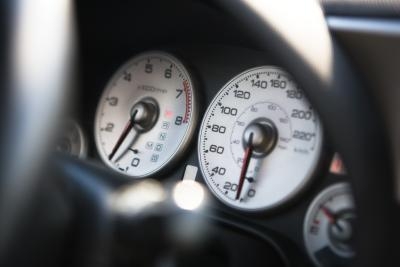
Today most vehicles come stock with rpm gauges, also known as tachometers. This was not always the case, especially back in the '60s and '70s. That did not stop the racers and serious car collectors from purchasing and installing their own units. Tachometers come in a variety of styles and sizes for vehicle owners who want to add a gauge to their cluster. Tachometers serve two important functions: They keep your engine rpm within safe limits, and they monitor engine speed for better fuel economy.
Place the vehicle in park or neutral with the emergency brake set. Raise the hood and disconnect the negative battery cable at its post. Check your owner's manual for the location of the coil. It's a small black cylinder that has two electrical posts. Remove the small nut from the negative (-) side and set it aside.
Open up your tachometer gauge kit. It will include the tachometer, a mounting ring for a steering wheel or
optional dashboard bracket mounts, the wires and electrical eyelet, and spade connectors. For the dashboard mount you will have to use a drill and drill bit to make the holes in the dash panel. Be careful not to drill into another component on the other side of the dash. Use a 1/8-inch bit to drill the holes in the dash panel. Mount the brackets to the dash panel with the kit screws.
Drill a larger 1/2-inch hole in the dash panel between or next to the brackets and run the wires through the hole. Mount the tachometer to the brackets with the small nuts and bolts provided. Run loops of black electrician's tape around the wire where they will enter the hole, to insulate them. Push the wires through the hole and let them hang.
Slip the ring mount over the steering wheel. Slip the tachometer under the ring and tighten with a flat-head screwdriver (for the steering mount configuration). Tape about six to eight inches of the wire together to form a small loop. Attach the loop to the steering wheel column with a tie strap. Let the wires hang.
Check your installation instructions. You should have four wires, possibly three. The green wire will go to the negative side of the ignition coil. Remove a grommet from the fire wall and push the green wire through the hole. Connect the green wire to the coil, using the eyelet connector. Tighten the small nut over the eyelet connector. Push the grommet back in the firewall. Take the black wire and ground it to any screw on the firewall, using an eyelet connector.
Remove the cover from your main fuse box panel, which will be under the dash or in the kick panel (check owner's manual). For engine compartment fuse blocks, run the white and red wire through the firewall grommet hole next to the green wire. Attach the red wire to any 12-volt fuse that runs an accessory, such as the radio, while the key is in the "on" position. Use the small spade connector. If you have an extra wire supplied with the kit, it will be for the tachometer illumination. Attach the white wire to the 12-volt instrument dash light fuse, using the proper connector.
Tuck your wires tight under the dash and tie them off with tape or tie straps. Make sure no wires interfere with the operation of the gas or brake pedal. Reconnect the negative battery cable and test drive.